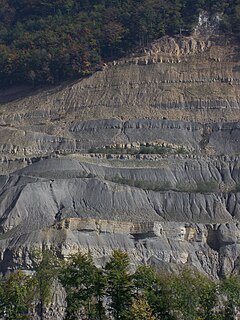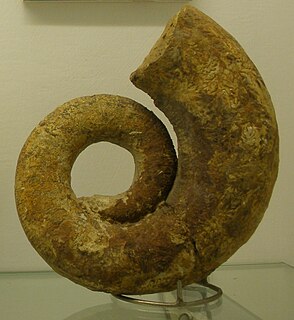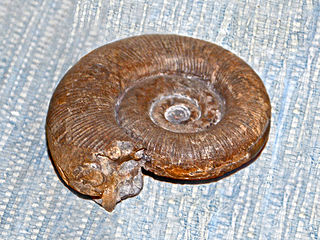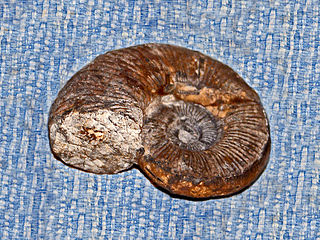
Ammon was an ancient Semitic-speaking nation occupying the east of the Jordan River, between the torrent valleys of Arnon and Jabbok, in present-day Jordan. The chief city of the country was Rabbah or Rabbath Ammon, site of the modern city of Amman, Jordan's capital. Milcom and Molech are named in the Hebrew Bible as the gods of Ammon. The people of this kingdom are called "Children of Ammon" or "Ammonites".

Ammonoids are a group of extinct marine mollusc animals in the subclass Ammonoidea of the class Cephalopoda. These molluscs, commonly referred to as ammonites, are more closely related to living coleoids than they are to shelled nautiloids such as the living Nautilus species. The earliest ammonites appeared during the Devonian, and the last species vanished in the Cretaceous–Paleogene extinction event.

The Barremian is an age in the geologic timescale between 129.4 ± 1.5 Ma and 125.0 ± 1.0 Ma). It is a subdivision of the Early Cretaceous epoch. It is preceded by the Hauterivian and followed by the Aptian stage.
The Early Jurassic epoch is the earliest of three epochs of the Jurassic period. The Early Jurassic starts immediately after the Triassic-Jurassic extinction event, 201.3 Ma, and ends at the start of the Middle Jurassic 174.1 Ma.
The Toarcian is, in the ICS' geologic timescale, an age and stage in the Early or Lower Jurassic. It spans the time between 182.7 Ma and 174.1 Ma. It follows the Pliensbachian and is followed by the Aalenian.
In the geologic timescale, the Bajocian is an age and stage in the Middle Jurassic. It lasted from approximately 170.3 Ma to around 168.3 Ma. The Bajocian age succeeds the Aalenian age and precedes the Bathonian age.
In the geologic timescale the Bathonian is an age and stage of the Middle Jurassic. It lasted from approximately 168.3 Ma to around 166.1 Ma. The Bathonian age succeeds the Bajocian age and precedes the Callovian age.
In the geological timescale, the Berriasian is an age/stage of the Early/Lower Cretaceous. It is the oldest subdivision in the entire Cretaceous. It has been taken to span the time between 145.0 ± 4.0 Ma and 139.8 ± 3.0 Ma. The Berriasian succeeds the Tithonian and precedes the Valanginian.
In the geologic timescale, the Callovian is an age and stage in the Middle Jurassic, lasting between 166.1 ± 4.0 Ma and 163.5 ± 4.0 Ma. It is the last stage of the Middle Jurassic, following the Bathonian and preceding the Oxfordian.
The Hauterivian is, in the geologic timescale, an age in the Early Cretaceous epoch or a stage in the Lower Cretaceous series. It spans the time between 132.9 ± 2 Ma and 129.4 ± 1.5 Ma. The Hauterivian is preceded by the Valanginian and succeeded by the Barremian.
The Hettangian is the earliest age and lowest stage of the Jurassic period of the geologic timescale. It spans the time between 201.3 ± 0.2 Ma and 199.3 ± 0.3 Ma. The Hettangian follows the Rhaetian and is followed by the Sinemurian.

In the geologic timescale, the Sinemurian is an age and stage in the Early or Lower Jurassic epoch or series. It spans the time between 199.3 ± 2 Ma and 190.8 ± 1.5 Ma. The Sinemurian is preceded by the Hettangian and is followed by the Pliensbachian.

The Oxfordian is, in the ICS' geologic timescale, the earliest age of the Late Jurassic epoch, or the lowest stage of the Upper Jurassic series. It spans the time between 163.5 ± 4 Ma and 157.3 ± 4 Ma. The Oxfordian is preceded by the Callovian and is followed by the Kimmeridgian.

Lytoceras is an ammonite genus that was extant during most of the Jurassic and Cretaceous periods, and is the type genus for the family Lytoceratidae. These cephalopods were fast-moving nektonic carnivores.

Cephalopod egg fossils are the fossilized remains of eggs laid by cephalopods. The fossil record of cephalopod eggs is scant since their soft, gelatinous eggs decompose quickly and have little chance to fossilize. Eggs laid by ammonoids are the best known and only a few putative examples of these have been discovered. The best preserved of these were discovered in the Jurassic Kimmeridge Clay of England. Currently no belemnoid egg fossils have ever been discovered although this may be because scientists have not properly searched for them rather than an actual absence from the fossil record.

Lytoceras batesi is an ammonite species belonging to the family Lytoceratidae. These cephalopods were fast-moving nektonic carnivores. They lived in the Cretaceous period.

Lytoceras cornucopia is an ammonite species belonging to the family Lytoceratidae. These cephalopods were fast-moving nektonic carnivores. They lived in the Jurassic period.

Lytoceras fimbriatum is an ammonite species belonging to the family Lytoceratidae. These cephalopods were fast-moving nektonic carnivores. They lived in the Jurassic period.

Padillasaurus is an extinct genus of titanosauriform sauropod known from the Early Cretaceous Paja Formation in Colombia. It contains a single species, Padillasaurus leivaensis, known only from a single partial axial skeleton. Initially described as a brachiosaurid, it was considered to be the first South American brachiosaurid ever discovered and named. Before its discovery, the only known brachiosaurid material on the continent was very fragmentary and from the Jurassic period. However, a more recent study finds it to be a basal somphospondylan.

Lytoceras sutile is an ammonite species belonging to the family Lytoceratidae. These cephalopods were fast-moving nektonic carnivores.












